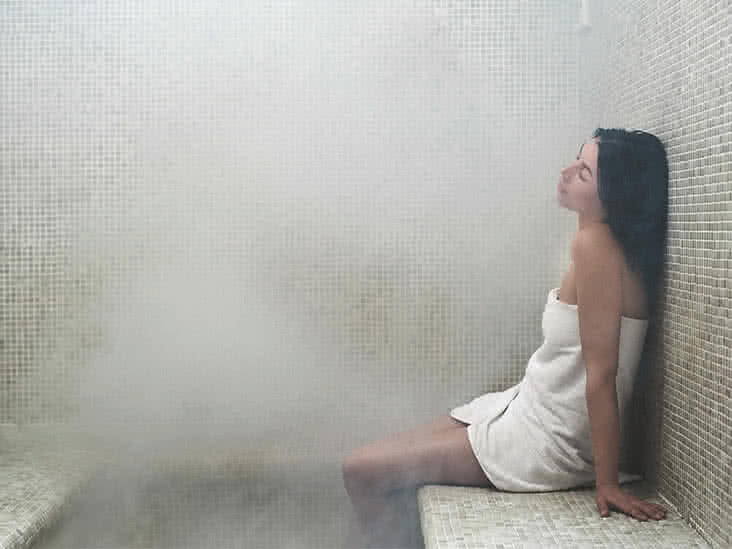Some of the benefits Of a Steam Bath After a Workout is that the moist heat can help relieve pain and lower muscle damage. Steam rooms might offer some relief by increasing blood flow to muscles. Experts used to think that these heated rooms only moved blood to the skin. However, they also shift blood from your core into your muscles.

Steam baths, also known as steam saunas or steam rooms, offer a unique and invigorating experience with potential health benefits.
Common Health Benefits Associated With Steam Bath Use:
- Improved Respiratory Health: The warm and humid environment of a steam bath can help open up the airways, loosen congestion, and promote easier breathing. It may provide temporary relief for respiratory conditions such as asthma, allergies, and sinus congestion.
- Relaxation and Stress Relief: Steam baths create a soothing and calming environment that can help reduce stress, relax the mind, and promote overall relaxation. Steam and warmth can have a positive impact on mood and mental well-being.
- Skin Health and Cleansing: The steam in a steam bath can help open up the pores and cleanse the skin. It can promote sweating, which aids in the removal of impurities and toxins from the skin, leaving it refreshed and revitalized.
- Muscle Relaxation: The warmth and moisture of a steam bath can help relax muscles, relieve tension, and soothe muscle aches and pains. It can be beneficial for post-workout recovery or general muscle relaxation.
- Improved Circulation: The heat and humidity in a steam bath can dilate blood vessels and promote improved blood circulation. This can enhance the delivery of oxygen and nutrients to tissues and promote overall cardiovascular health.
- Detoxification: Similar to saunas, steam baths can help stimulate sweating, which aids in the elimination of toxins and waste products from the body, supporting detoxification.
- Stress Reduction and Sleep Enhancement: Regular use of steam baths can contribute to stress reduction and improved sleep quality. The relaxation and soothing effects can help promote a sense of well-being and improve sleep patterns.
Disadvantages Of Steam Bath
Steam sessions should last no longer than 15 minutes (10 minutes if you’re new to steam therapy). With that in mind, here are seven things you should do after you take a steam bath. Drink at least 8 ounces of water.
It’s important to note that steam baths may not be suitable for everyone, particularly individuals with certain health conditions or those who are pregnant. As always, it’s recommended to consult with a healthcare professional before using a steam bath, especially if you have any underlying medical conditions or concerns.
It’s essential to listen to your body’s signals, stay hydrated, and limit the duration of your steam bath sessions to prevent dehydration or overheating. Additionally, maintaining proper hygiene and following the facility’s guidelines for steam bath use are important to ensure cleanliness and safety.
While steam baths can offer various health benefits, there are a few potential disadvantages to be aware of
- Dehydration: The high humidity and heat in a steam bath can cause excessive sweating, leading to fluid loss and dehydration. It’s crucial to stay well-hydrated before, during, and after a steam bath session to prevent dehydration. Individuals who are more susceptible to dehydration, such as older adults or those with certain medical conditions, should take extra precautions.
- Overheating: Spending an extended period of time in a steam bath can cause overheating, especially if the individual is unable to tolerate the high temperature and humidity. This can lead to symptoms such as dizziness, lightheadedness, or even fainting. It’s important to listen to your body and exit the steam bath if you start feeling uncomfortable or overheated.
- Respiratory Sensitivity: While steam baths can help relieve respiratory congestion for some individuals, others with respiratory conditions like asthma or chronic obstructive pulmonary disease (COPD) may find the moist environment irritating to their airways. It’s advisable to consult with a healthcare professional if you have any respiratory concerns before using a steam bath.
- Skin Sensitivity: The heat and humidity in a steam bath can potentially aggravate certain skin conditions, such as eczema or rosacea, in some individuals. It’s recommended to be mindful of your skin’s sensitivity and seek medical advice if you have specific skin concerns.
- Contagion Risk: Public or shared steam baths may carry a risk of spreading infections or contagious diseases if proper sanitation and hygiene practices are not followed. It’s important to choose a reputable facility that maintains high cleanliness standards and follows the guidelines provided.
- Pregnancy and Certain Medical Conditions: Pregnant women, individuals with cardiovascular conditions, uncontrolled hypertension, or certain medical conditions should consult with a healthcare professional before using a steam bath. The high temperature and humidity may not be suitable for everyone, and it’s important to prioritize your safety and well-being.
It’s essential to use steam baths in moderation, monitor your body’s response, and be aware of any personal limitations or health concerns. If you have any specific health conditions or uncertainties, it’s best to consult with a healthcare professional for personalized advice
Summary
Steam rooms offer many health benefits for joints, circulation, skin, and sinuses. They work using a combination of high heat and humidity to relax muscles and soothe nerves. Steam rooms are not without risk, however. Users should be mindful of possible bacteria and fungi that may thrive in warm, humid environments.
Overall, steam baths can be a refreshing and enjoyable experience with potential health benefits, but it’s important to use them responsibly and according to your own comfort level and health considerations.



